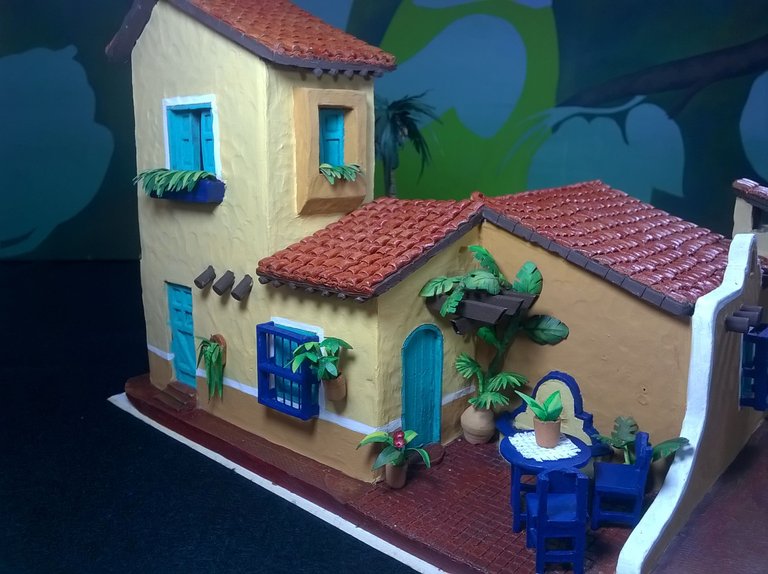
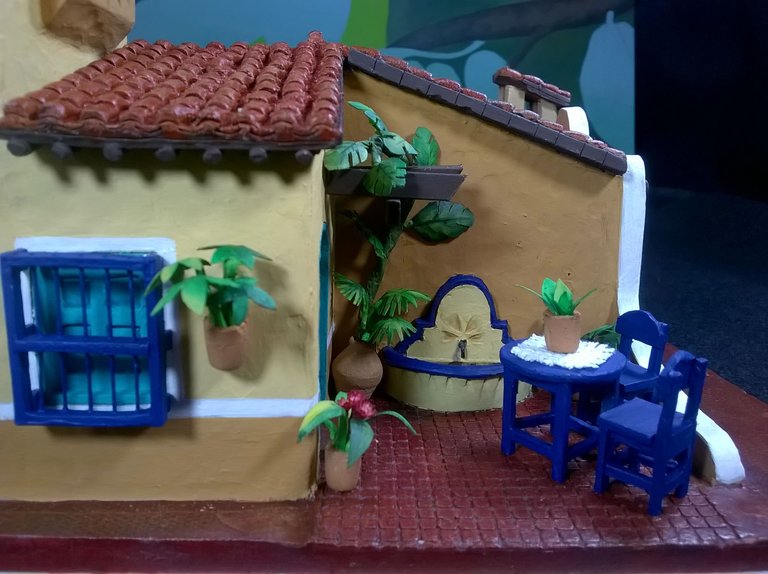
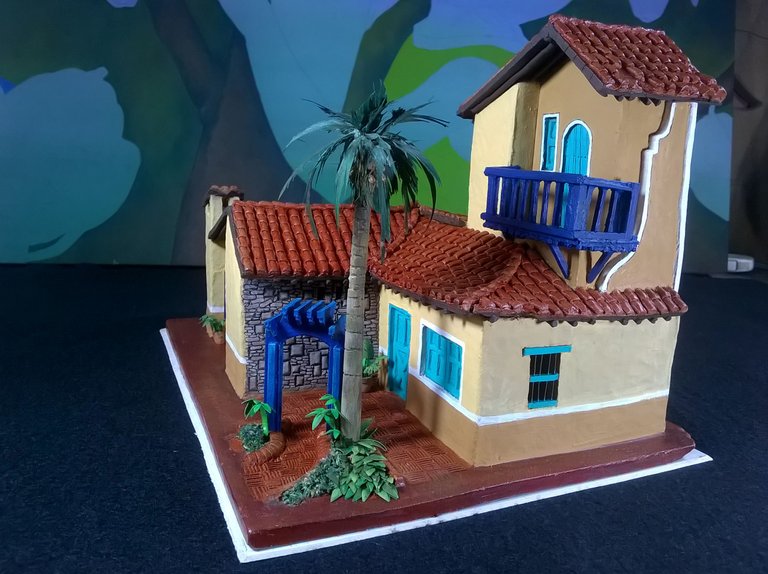
Instagram de mi papá Jesús: https://www.instagram.com/jesusmendez2308/
Instagram of my dad:https://www.instagram.com/jesusmendez2308/
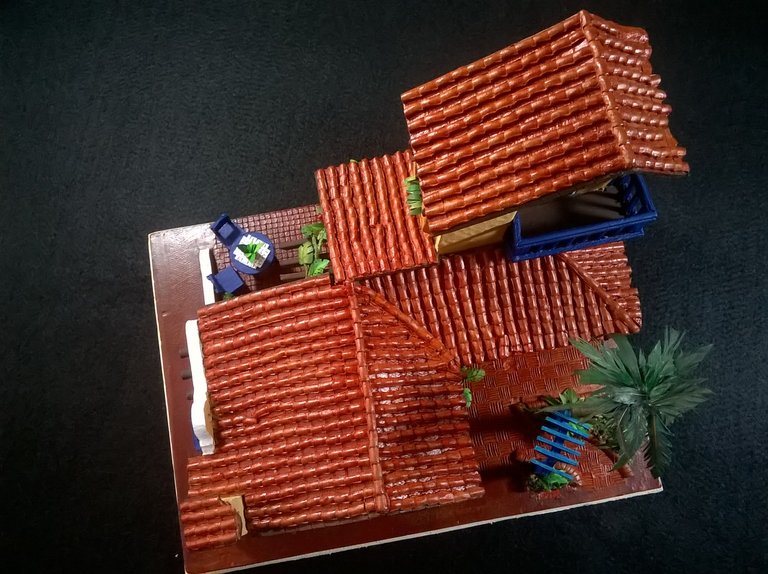
ESPAÑOL.
Hola amigos de Hive, espero que estén pasando un día maravilloso... Hoy quiero compartir algo sencillo que forma parte de la cultura de mi familia, pero que estoy segura que muchas personas disfrutaran, porque nos traen recuerdos de nuestra infancia, de aquellos días cuando contemplamos por primera vez un nacimiento (conocido en otros lugares como Belenes), elaborado tradicionalmente en época de Navidad. Esta costumbre se ha trasformado con el tiempo, desarrollando un tipo de artesanía que en Venezuela se realiza en cualquier época del año, y cualquier parte del país, elaborando casitas o fachadas en miniatura, generalmente alusivas a las diferentes regiones de Venezuela, tratando de imitar construcciones coloniales con techos de tejas, o de casas viejas muy humildes o de fachadas, donde se incorporan detalles en miniatura, que las personas disfrutan cuando son descubiertos o reconocidos, y mientras más pequeños sean los detalles, pareciera que son más queridos por las personas. Este tipo de artesanía tiene la versatilidad de que puede elaborarse, en su forma más básica con un material que hay en cualquier parte del planeta: ARCILLA. En su procesamiento intervienen el Agua y el Fuego, y el trabajo para transformarla en objetos utilitarios o decorativos, está dentro de los oficios más antiguos de la historia y ha sido parte de las actividades comunes en mi casa, donde siempre ha habido un torno, una laminadora, un horno cerámico.
Mis padres siempre han tenido una fascinación por el trabajo realizado con Arcilla: platos, tazas, y cualquier otro objeto utilitario… quizás por las posibilidades artísticas o artesanales que presenta un material tan moldeable… En el artículo de hoy, les hablaré y mostraré un poquito del trabajo que elabora mi papá y que el disfruta realizando, porque según él, cuando trabaja con casas en miniatura, siente que puede seguir jugando como cuando era un niño, pasan las horas y no se agota.
Realicé una pequeña entrevista a mi papá, Jesús Méndez, para conocer acerca del trabajo artesanal en arcilla:
¿Cómo empezaste a hacer este trabajo?
“Empecé elaborando casas sencillas y experimentando, me familiaricé poco a poco con su comportamiento, dureza, mejor momento para cortarla o pegarla, mejor grosor para cada trabajo, tiempo de secado, resultados de acuerdo a las temperaturas de cocción, en resumen, fui descubriendo y desarrollando mis propias técnicas y estilo con la práctica.”
¿Por qué lo haces y cuál es tu inspiración?
“Me gusta la arquitectura colonial y tradicional de distintos lugares de Venezuela… hacer estas casitas es un pasatiempo que me relaja y disfruto mucho.”
¿Qué es lo que más te gusta de tu trabajo?
“Existen tres momentos que disfruto cuando elaboro una casa: El primer momento es cuando empiezo a imaginar cómo será la casa, como será su fachada y que tipo de estructura tendrá cuál será su contenido, imaginación que después toca llevar al papel para empezar a darle forma. Lo segundo que disfruto es armarla cuando ya están todas las piezas cortadas. Es como cuando armas un rompecabezas, solo que en este caso es tridimensional y puedes ver la estructura armada por los distintos ángulos y además puedes agregar o modificar detalles, porque mientras la arcilla esta con una consistencia suave es como la plastilina, solo que mejor. El tercer momento que disfruto es cuando ya está horneada y comienza el proceso de pintar y colocar los detalles, porque se me ocurren muchas ideas tratando de llevar a miniatura, recreando ambientes y objetos que las personas puedan identificar como elementos típicos de una época o región, siempre buscando obtener la mayor similitud con la realidad pero en tamaño proporcional a la casa o la fachada, como por ejemplo algo tan común como el medidor de la luz, una ventana vieja, el mobiliario, las tejas y cualquier cosa que surja de la imaginación.”
¿Qué materiales utilizas para elaborar una casita promedio?
Arcilla Roja (1 a 2 kilos). Además: Agua; Rodillo; Gubias; Paletas; Pinceles; Implementos específicos o improvisados para modelar la arcilla; Madera; Cartón; Exacto o herramienta de corte; Tijera; Lápices; Pinturas; Horno para quemar la pieza.
¿Cómo es el proceso?
“Primero realizo un boceto o, tomo fotografías o busco imágenes del modelo de casa que quiero reproducir, hago una matriz en cartulina o cartón, para lo cual estimo las proporciones de la estructura y realizo los patrones con las medidas deseadas.
Luego preparo y amaso la arcilla, procedo a hacer suficientes láminas para luego cortar las paredes de la casa guiándome con los patrones o matriz que hice previamente, utilizándolos como plantilla para cortar cada pieza.
Después armo o ensamblo la estructura la cual es pegada con una mezcla que se hace de la misma arcilla con un poco más de agua y que preparo en un envase hasta que queda con una textura de crema, ésta la voy aplicando con un pincel donde quiero realizar uniones ya que actúa igual que un pegamento.
Una vez que la casa esta armada, se deja secar muy lentamente para que no se deforme o se pandee, la cubro con un plástico dejándola por cinco días (dependiendo de la humedad del ambiente) luego retiro el plástico y la dejo tres días más para que seque bien. Cuando está bien seca, se introduce en un horno cerámico que puede ser a gas o eléctrico o rudimentario a leña, pero que alcance una temperatura de aproximadamente 500º Centígrados. Esto para conseguir la dureza y el color rojo típico de las tejas de arcilla. Por último se pintan las paredes y se agregan los distintos detalles decorativos para lo cual se utilizan los materiales de que dispongas y que sirvan para fabricar los objetos que surjan de tu imaginación.”

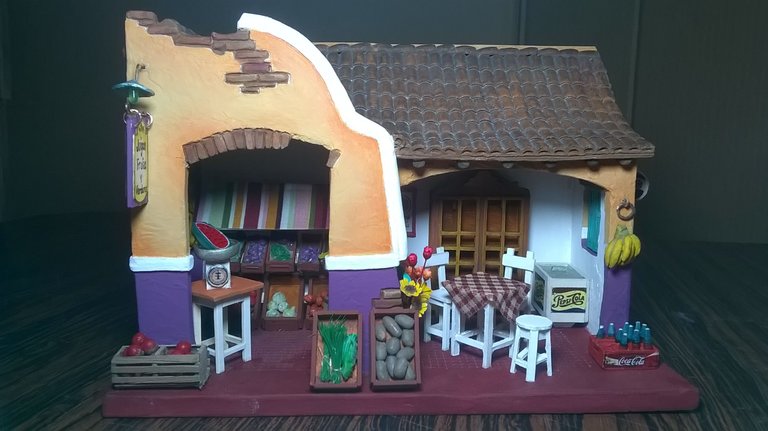

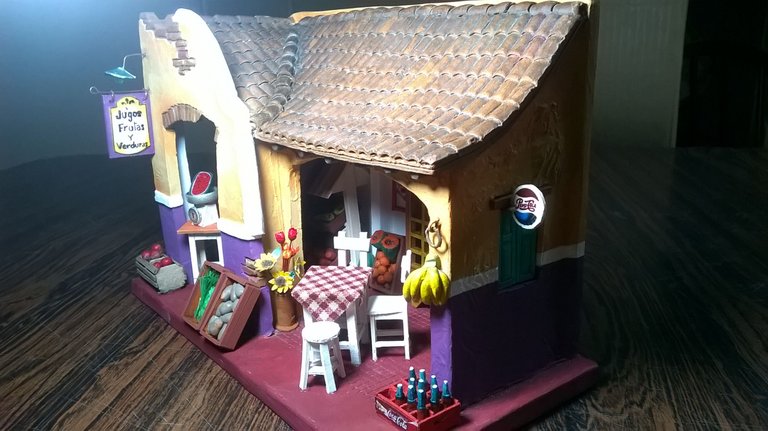

ENGLISH.
Hello friends of Hive, I hope you are having a wonderful day.... Today I want to share something simple that is part of my family's culture, but that I am sure many people will enjoy, because it brings back memories of our childhood, of those days when we contemplated for the first time a nativity scene (known in other places as Nativity Scenes), traditionally made at Christmas time. This custom has been transformed over time, developing a type of handicraft that in Venezuela is done at any time of the year, and anywhere in the country, making miniature houses or facades, usually alluding to the different regions of Venezuela, trying to imitate colonial buildings with tile roofs, or very humble old houses or facades, where miniature details are incorporated, which people enjoy when they are discovered or recognized, and the smaller the details, it seems that they are more loved by people. This type of handicraft has the versatility that can be elaborated, in its most basic form, with a material that can be found anywhere on the planet: CLAY. Water and fire are involved in its processing, and the work to transform it into utilitarian or decorative objects is among the oldest crafts in history and has been part of the common activities in my house, where there has always been a potter's wheel, a rolling mill, a ceramic kiln.
My parents have always had a fascination for the work done with clay: plates, cups, and pots... perhaps because of the artistic or handicraft possibilities that such a moldable material presents... In today's article, I will talk about and show you a little bit of the work that my dad does and that he enjoys doing, because according to him, when he works with miniature houses, he feels that he can keep playing like when he was a child, hours go by and he doesn't get exhausted.
I conducted a short interview with my father, Jesús Méndez, to learn more about his clay craftsmanship:
How did you start doing this work?
"I started by making simple houses and experimenting, I gradually became familiar with its behavior, hardness, best time to cut or glue it, best thickness for each job, drying time, results according to firing temperatures, in short, I was discovering and developing my own techniques and style with practice."
Why do you do it and what is your inspiration?
"I like the colonial and traditional architecture of different places in Venezuela... making these little houses is a hobby that relaxes me and I enjoy a lot."
What do you like most about your work?
"There are three moments that I enjoy when I design a house: The first moment is when I start to imagine what the house will be like, what its façade will be like and what kind of structure it will have what its contents will be, imagination that then it's time to put to paper to start shaping it. The second thing I enjoy is putting it together when all the pieces are already cut. It's like when you put together a puzzle, only in this case it's three-dimensional and you can see the assembled structure from different angles and you can also add or modify details, because while the clay has a soft consistency it's like plasticine, only better. The third moment I enjoy is when it is already baked and the process of painting and placing the details begins, because I come up with many ideas trying to bring to miniature, recreating environments and objects that people can identify as typical elements of an era or region, always seeking to obtain the greatest similarity with reality but in proportional size to the house or facade, such as something as common as the light meter, an old window, furniture, tiles and anything that arises from the imagination."
What materials do you use to make an average house?
Red clay (1 to 2 kilos). Also: Water; Roller; Gouges; Trowels; Brushes; Specific or improvised implements to model the clay; Wood; Cardboard; Exact or cutting tool; Scissors; Pencils; Paints; Oven to burn the piece.
What is the process like?
"First I make a sketch or, I take photographs or look for images of the model house I want to reproduce, I make a matrix on cardboard or cardboard, for which I estimate the proportions of the structure and make the patterns with the desired measurements.
Then I prepare and knead the clay, proceed to make enough sheets to then cut the walls of the house guided by the patterns or matrix that I made previously, using them as a template to cut each piece.
Then I assemble the structure which is glued with a mixture that is made from the same clay with a little more water and that I prepare in a container until it has a creamy texture, I apply it with a brush where I want to make joints because it acts like a glue.
Once the house is assembled, it is left to dry very slowly so that it does not deform or warp, I cover it with plastic, leaving it for five days (depending on the humidity of the environment), then I remove the plastic and leave it for three more days to dry well. When it is well dried, it is introduced in a ceramic oven that can be gas or electric or rudimentary to firewood, but that reaches a temperature of approximately 500º Celsius. This is to achieve the hardness and red color typical of clay tiles. Finally, the walls are painted and the various decorative details are added, using whatever materials you have available to make the objects that arise from your imagination."
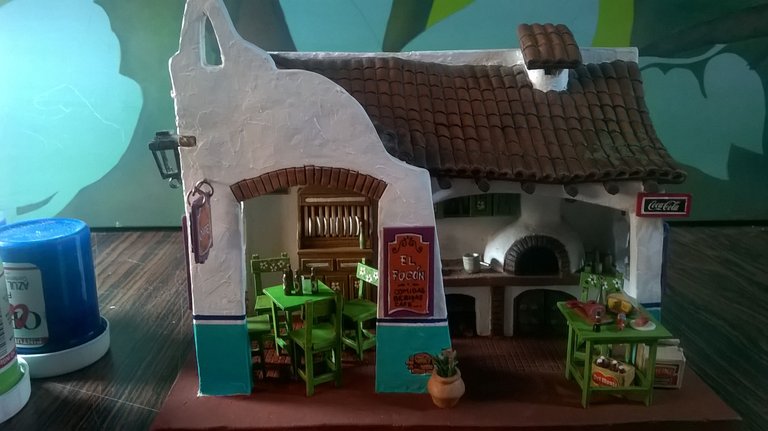
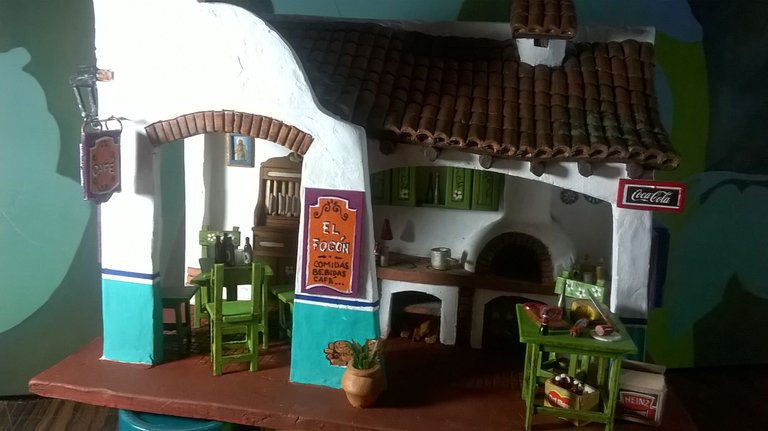
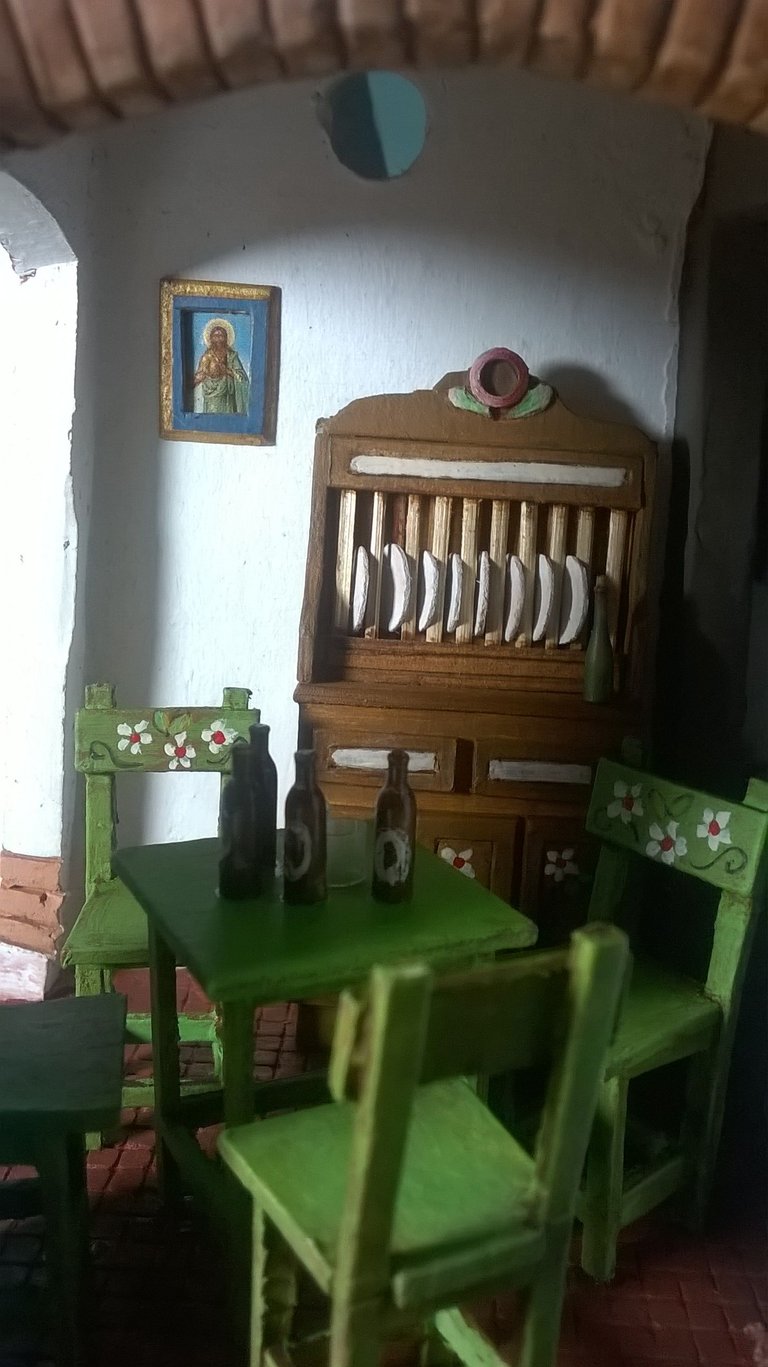
Instagram de mi papá Jesús: https://www.instagram.com/jesusmendez2308/
Instagram of my dad:https://www.instagram.com/jesusmendez2308/
Mi Instagram: https://www.instagram.com/malena_arte/
Para Traducir utilice: https://www.deepl.com/es/translator
For translation use: https://www.deepl.com/es/translator
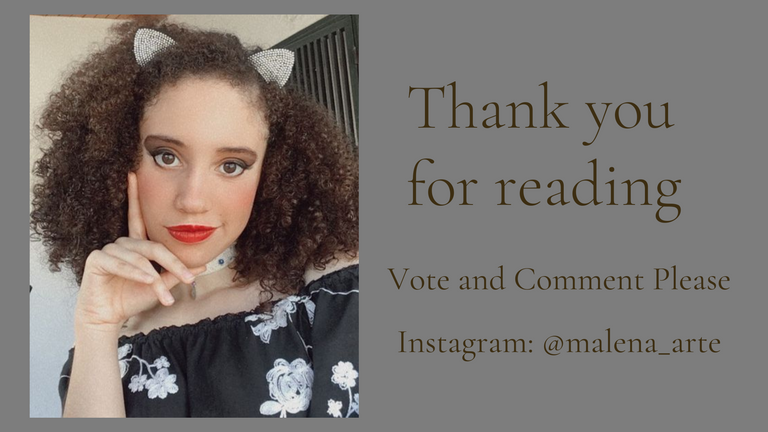
Thank you for sharing this amazing post on HIVE!
non-profit curation initiative!Your content got selected by our fellow curator @priyanarc & you just received a little thank you via an upvote from our
You will be featured in one of our recurring curation compilations and on our pinterest boards! Both are aiming to offer you a stage to widen your audience within and outside of the DIY scene of hive.
Join the official DIYHub community on HIVE and show us more of your amazing work and feel free to connect with us and other DIYers via our discord server: https://discord.gg/mY5uCfQ !
If you want to support our goal to motivate other DIY/art/music/homesteading/... creators just delegate to us and earn 100% of your curation rewards!
Stay creative & hive on!
thank you very much😀